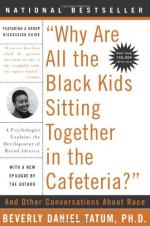
|
| Name: _________________________ | Period: ___________________ |
This quiz consists of 5 multiple choice and 5 short answer questions through Part IV, Beyond Black and White, Chapter 9, Identity Development in Multiracial Families.
Multiple Choice Questions
1. In Part III, Understanding Whiteness in a White Context, Chapter 6, The Development of White Identity, Tatum recommends that whites find most positive redefinition by what means?
(a) Allying with Asian resistors of racism.
(b) Allying with black resistors of racism.
(c) Ignoring the values of race.
(d) Allying with other white resistors of racism.
2. What concept defined by the author holds the extended family as a reference group for social support?
(a) Matrilineality.
(b) Marginalization.
(c) Miscegenation.
(d) Familism.
3. Tatum describes the ethic group of Asians, including Pacific Islanders, East Asians, Southeast Asians and South Asians as comprising how many people?
(a) 7 million.
(b) 25 million.
(c) 4 million.
(d) 12 million.
4. Native American groups constitute around how many people, according to the author?
(a) 250,000.
(b) 750,000.
(c) 2 million.
(d) 5 million.
5. One advantage of affirmative action in helping blacks avoid racism is that they do not need to do what, according to the author?
(a) Petition for better treatment.
(b) Agree to make changes.
(c) Agree with the system.
(d) See their mistreatment.
Short Answer Questions
1. Tatum claims that the idea that biracial children suffer in a particular way during childhood is what in Part IV, Beyond Black and White, Chapter 9, Identity Development in Multiracial Families?
2. Tatum writes in Part III, Understanding Whiteness in a White Context, Chapter 6, The Development of White Identity that many Whites' only sense of Whiteness is that it is "normal," but true, positive white identity should be based in what?
3. Beverly Daniel Tatum received her B.A. in psychology from which institution?
4. Beverly Daniel Tatum received an M.A. in religious studies from which institution?
5. What is the third stage of William E. Cross, Jr.'s theory of Nigrescence?
|
This section contains 297 words (approx. 1 page at 300 words per page) |

|




